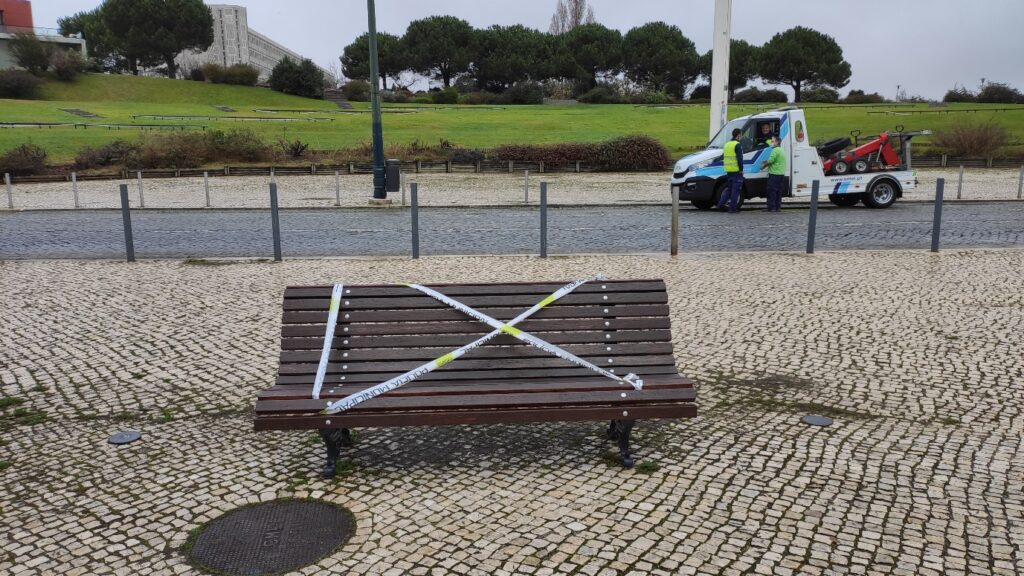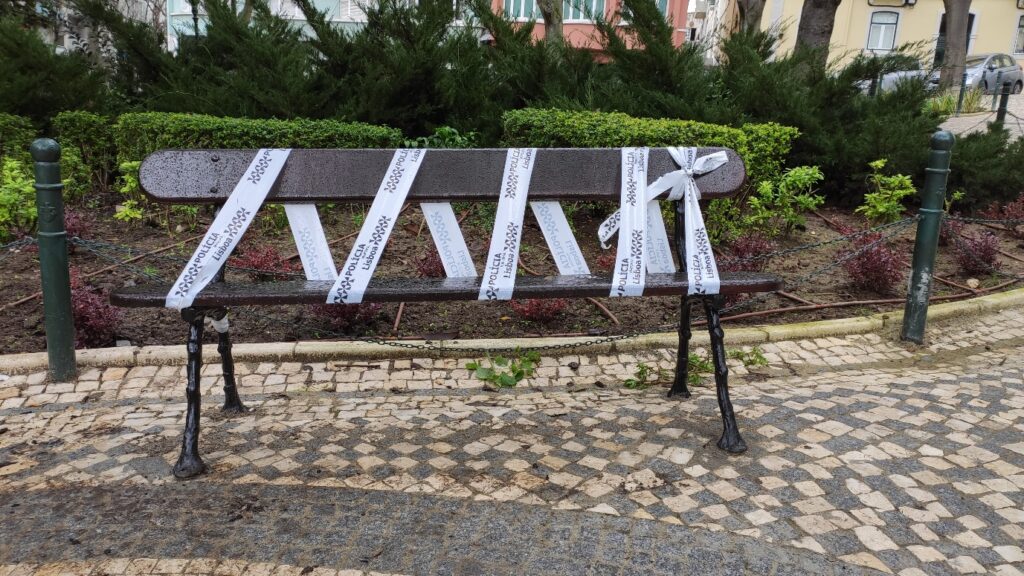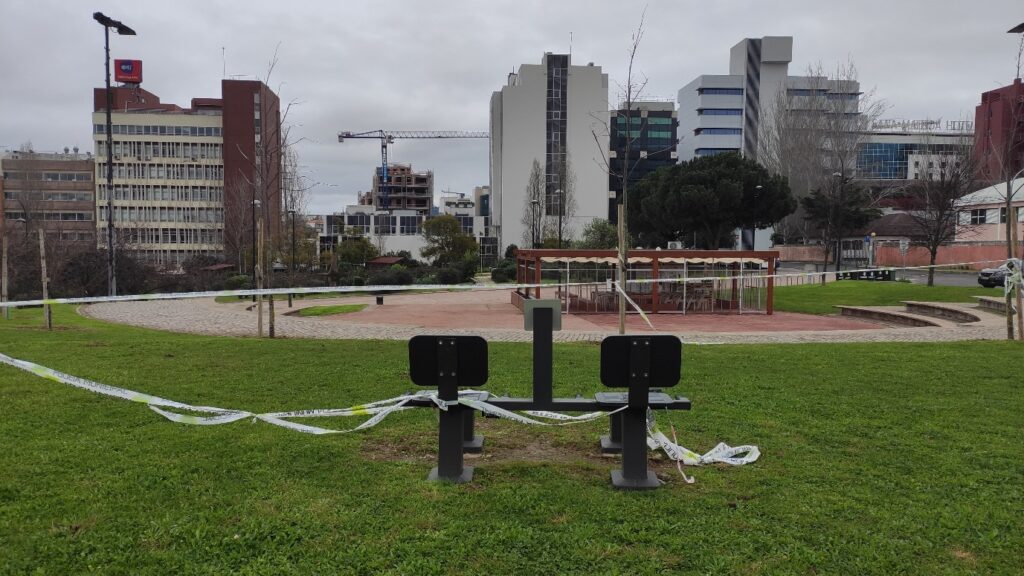Simone Tulumello (Instituto de Ciências Sociais, Universidade de Lisboa; Urban Transitions Hub, https://urbantransitionshub.org/)
On 15 January 2021, amid a dramatic spike in cases of Covid-19 that followed Christmas holidays, a renovated state of emergency put Portugal in national lockdown for the second time. The following week, amid emerging moral panics on the allegedly scarce compliance of the populace (Tulumello 2021), the lockdown has been tightened: among other measures, the government ordered that “parks and gardens shall from now on be exclusively used for passing by; lingering in these places is therefore banned” (Presidência do Conselho de Ministros 2021) – and called for more police presence to enforce these regulations. Even machines for individual exercise have been closed, amid vague allegations about risks of gathering and the impossibility to disinfect their surfaces after every use.
Matthew Hannah (2021), in his insightful review of Deadly Biocultures: The Ethics of Life-Making, has argued that Covid-19 policies have created a fundamental conflict between “live longer” and “live/age well”, giving priority to the former in the name of patience and the “hope” of a soon-to-be panacea (vaccination or whatnot). But while this trade-off was, to some extent, inevitable in early 2020, when scientists and governments worked in an environment of substantial darkness with respect to the paths of transmission of SARS-CoV-2, things are different one year later. This year has seen the emergence of a substantial consensus over transmission: Covid-19 is almost exclusively transmitted through droplets and aerosols, while aeration and UV rays (that is, sunlight) reduce dramatically its capacity to infect – in short, Covid-19 is transmitted by air, and indoors.
So how to interpret the insistence on measures that limit the use of outdoor spaces in 2021? Adopting a Foucauldian lens, Hannah and his colleagues (2020) have suggested that “the current situation is clearly one example of a constellation in which elements of sovereignty, discipline, biopower and biopolitics, and governmentality are combined in uneven – as well as geographically situated and rapidly shifting – ways”. This approach seems to me to be particularly adequate to shed some light on the, often apparently contradictory, rationale of policies being adopted around the world. Contradictory, as in policies that run somehow against, if not in blatant opposition to, scientific evidence on transmission – even more contradictory when implemented by governments that otherwise request citizens to acknowledge and abide by scientific knowledge. And yet apparently, since governmental rationalities, beyond concealing unspoken goals, do result from complex mediations among conflicting instances. In this sense, claiming that governments have always seen the populace as being inherently dangerous and to be disciplined, that they have taken advantage of the pandemic to implement draconian, anti-democratic measures they always wished to implement is indeed part of the explanation. And yet it is not enough, as governments are also dealing with social fears and panics, including their own fears and panics – plus economic and vested interests, and even a scientific discourse that is still much in the making and therefore often contradictory in and of itself.
In this visual essay, I intend to provide a somewhat minor contribution to these explorations, by giving visibility to the apparently contradictory nature of one such policies: the disciplination of public spaces in a time that would call for more use of public spaces. By doing so, I hope to contribute to problematise those measures, but without being yet able to conclude on the specific constellation of governmentalities at play – we know that something is deeply wrong here, but we still need to make complete sense of it.
In what follows, I will juxtapose photos of public spaces I took in Lisbon during the second lockdown (in the context of a mini-project, “Ethnography on the Run: Jogging Through Portugal’s Second Lockdown”)[1] with excerpts from scientific texts, published during this year, on Covid-19 transmission and health implications. Texts are either peer-reviewed research articles or commentaries that build on other researches; all texts are published in reputable journals with one exception (a pre-print, which I have screened for consistency – though I am not able to judge on the specifics of the research).

“While it has been acknowledged that spending time outside has general health benefits, our review posits that there are also benefits in reducing transmission of SARS-CoV-2 by reducing exposure time (substituting time indoors with time outdoors). These results suggest that moving activities to outdoor settings may reduce infections and ultimately save lives.” (Bulfone et al. 2020)
“Our results show that utilising green spaces rather than other activities (e.g. visiting shops and workplaces) can reduce the transmission rate of Covid-19, especially during an exponential phase of transmission.” (Johnson et al. 2020)


“Some of the restrictions designed to reduce SARS-CoV-2 spread impact specifically on these same groups by limiting their activity and access to preventive or health promotion services. Greenspaces, accessed with social distancing, may mitigate some of the predicted negative health effects of Covid-19 restrictions.” (Geary et al. 2021)
“We estimated that outdoor recreational activity increased by 291% during lockdown relative to a 3 yr average for the same days … [P]edestrian activity increased in city parks, peri-urban forest, as well as protected areas, highlighting the importance of access to green open spaces that are interwoven within the built-up matrix. These findings shed new light on the value of urban nature as resilience infrastructure during a time of crisis.” (Venter et al. 2020)


“Demand from residents for parks and outdoor green spaces has increased since the outbreak began, and highlights the important role and benefits provided by parks, especially urban and community parks, under the Covid-19 pandemic … In particular, parks could be utilized during pandemics to increase the physical and mental health and social well-being of individuals.” (Geng et al. 2020)

“The importance of engaging in any type of physical activity regularly, for both physical and mental health, is well established, and may be particularly beneficial in protecting the body and limiting the damage caused by the coronavirus disease 2019 (Covid-19). Exposure to nature or green space also has positive physical and mental health benefits. Closures of parks and green spaces during the Covid-19 pandemic has limited the options for physical activity and may affect vulnerable populations more than others. We provide both short-term and long-term recommendations to encourage access to green space for people while allowing for physical distancing.” (Slater et al. 2020)
“Regular physical activity benefits both physical and mental health in the long- and short-term. Risk factor analysis for the most severe Covid-19 cases indicates a link to obesity, obesity-related conditions, such as hypertension and type 2 diabetes mellitus, older age, racial and ethnic minority status, and physical inactivity.” (Denay et al. 2020)
“[T]he reduction of total physical activity had a profoundly negative impact on psychological health and well-being of population. Based on this scientific evidence, maintaining a regular exercise routine is a key strategy for physical and mental health during a forced rest period like the current coronavirus emergency.” (Maugeri et al. 2020)


“During quarantine, staying active and maintaining a physical exercise routine will be essential for mental and physical health … We hence encourage national, federal and regional governments around the world to include clear exceptions for physical activity in nationwide lockdowns. These should also allow for safe performance of outdoor physical activities (e.g. walking, running or other individual sports, where an adequate interpersonal distance can be maintained), and thus prevent the Covid-19 pandemic from generating unfavourable cardiovascular consequences due to acute cessation of physical activity.” (Lippi et al. 2020)
“The purpose of this study was to assess the immediate changes in physical activity, play, sedentary behaviours, leisure screen time, and sleep in school-aged children and youth across Canada during the initial period of the Covid-19 crisis. We found that children and youth were less active, played outside less, were more sedentary, engaged in more recreational screen-based activities, and slept more during the initial Covid-19 virus outbreak compared with before the restrictions … [W]e recommend that: … Public health officials support parents by implementing safe physical distancing measures that provide extra space for everyone to walk, cycle, wheel, and scoot. This could include temporary reallocation of roadway space and keeping expansive green spaces open.” (Moore et al. 2020)



“A year into the pandemic, the evidence is now clear. The coronavirus SARS-CoV-2 is transmitted predominantly through the air – by people talking and breathing out large droplets and small particles called aerosols. Catching the virus from surfaces – although plausible – seems to be rare.” (Nature 2021)

Acknowledgements
I am grateful to Giulia Strippoli for her comments on a preliminary version of the essay and Andrew Kent from Antipode for the careful, supportive editorial work.
Endnote
[1] “Ethnography on the Run” is an (auto-)ethnographic project I am developing during the lockdown. Through regular urban runs, I am collecting observations of the way human activity is (re-)shaped amid the lockdown, with the additional goal of reflecting on my own feelings and sensations as a runner, and how they interact with my interests and questions as a social researcher. I am regularly reporting from the project here: https://simonetulumello.wordpress.com/ethnography-on-the-run/
References
Bulfone T C, Malekinejad M, Rutherford G W and Razani N (2020) Outdoor transmission of SARS-CoV-2 and other respiratory viruses: A systematic review. The Journal of Infectious Diseases https://doi.org/10.1093/infdis/jiaa742
Denay K L, Breslow R G, Turner M N, Nieman D C, Roberts W O and Best T M (2020) ACSM call to action statement: Covid-19 considerations for sports and physical activity. Current Sports Medicine Reports https://doi.org/10.1249/JSR.0000000000000739
Geary R S, Wheeler B, Lovell R, Jepson R, Hunter R and Rodgers S (2021) A call to action: Improving urban green spaces to reduce health inequalities exacerbated by Covid-19. Preventive Medicine https://doi.org/10.1016/j.ypmed.2021.106425
Geng D C, Innes J, Wu W and Wang G (2021) Impacts of Covid-19 pandemic on urban park visitation: A global analysis. Journal of Forestry Research https://doi.org/10.1007/s11676-020-01249-w
Hannah M (2021) Book review: Nadine Ehlers and Shiloh Krupar’s Deadly Biocultures: The Ethics of Life-Making. AntipodeOnline.org 15 January https://antipodeonline.org/2021/01/15/deadly-biocultures/ (last accessed 10 February 2021)
Hannah M, Hutta J S and Schemann C (2020) Thinking through Covid-19 responses with Foucault – An initial overview. AntipodeOnline.org 5 May https://antipodeonline.org/2020/05/05/thinking-through-covid-19-responses-with-foucault/ (last accessed 10 February 2021)
Johnson T F, Hordley L A, Greenwell M P and Evans L C (2020) Effect of park use and landscape structure on Covid-19 transmission rates. medRxiv https://doi.org/10.1101/2020.10.20.20215731
Lippi G, Henry B M and Sanchis-Gomar F (2020) Physical inactivity and cardiovascular disease at the time of coronavirus disease 2019 (COVID-19). European Journal of Preventive Cardiology https://doi.org/10.1177/2047487320916823
Maugeri G, Castrogiovanni P, Battaglia G, Pippi R, D’Agata V, Palma A, Di Rosa M and Musumeci G (2020) The impact of physical activity on psychological health during Covid-19 pandemic in Italy. Heliyon https://doi.org/10.1016/j.heliyon.2020.e04315
Moore S A, Faulkner G, Rhodes R E, Brussoni M, Chulak-Bozzer T, Ferguson L J, Mitra R, O’Reilly N, Spence J C, Vanderloo L M and Tremblay M S (2020) Impact of the COVID-19 virus outbreak on movement and play behaviours of Canadian children and youth: A national survey. International Journal of Behavioral Nutrition and Physical Activity https://doi.org/10.1186/s12966-020-00987-8
Nature (2021) Editorial: Coronavirus is in the air – there’s too much focus on surfaces. 2 February https://www.nature.com/articles/d41586-021-00277-8 (last accessed 10 February 2021)
Presidência do Conselho de Ministros (2021) “Decreto no. 3-B/2021 de 19 de janeiro.” https://data.dre.pt/web/guest/pesquisa/-/search/154483156/details/maximized (last accessed 10 February 2021)
Slater S J, Christiana R W and Gustat J (2020) Recommendations for keeping parks and green space accessible for mental and physical health during Covid-19 and other pandemics. Preventing Chronic Disease http://dx.doi.org/10.5888/pcd17.200204
Tulumello S (2021) Ethnography on the run 1: The “café ao postigo” moral panic. Ethnography on the Run: Jogging Through Portugal’s Second Lockdown 18 January https://simonetulumello.wordpress.com/2021/01/18/ethnography-on-the-run-1-the-cafe-ao-postigo-moral-panic/ (last accessed 10 February 2021)
Venter Z S, Barton D N, Gundersen V, Figari H and Nowell M (2020) Urban nature in a time of crisis: recreational use of green space increases during the Covid-19 outbreak in Oslo, Norway. Environmental Research Letters https://doi.org/10.1088/1748-9326/abb396
